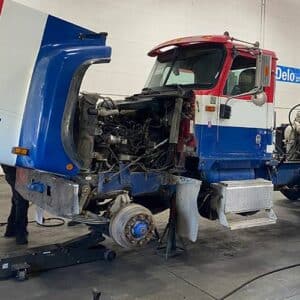They are installed on the front or rear axle of a vehicle and work by providing additional support that helps relieve the pressure placed on the axle by extra weight. In addition to supporting extra weight, leaf springs help keep tires in alignment and absorb shock resulting from driving over potholes, bumps and rough roads
CAN LEAF SPRINGS BE REPAIRED?
Leaf spring repair is a multi-step process that can be difficult, especially if you don’t have access to the appropriate equipment. Steps include jacking your truck, then safely removing the surrounding items before finally removing the springs. The repair process can be more complicated and even dangerous for semis and other large vehicles.
Having a repair shop replace your leaf springs can ensure that the correct spring is installed safely for your vehicle and load capacity. Installing the incorrect spring can result in premature wear that impacts the life expectancy of leaf springs and leads to more frequent replacement of the leaf springs and other suspension components.
Most leaf springs will last for several years, but factors such as cargo load and exposure to the elements can cause extra strain or corrosion that may increase the frequency at which they need to be replaced.
COMMON SIGNS YOUR LEAF SPRINGS NEED TO BE REPLACED
Common signs of leaf springs needing to be replaced include the presence of cracks and fractures or a change in the way your vehicle drives. You may also notice your vehicle leans to one side when there is no load present. Other signs that your leaf springs need repair or replacement occur while you are driving and can include one or more of the following symptoms:
- Difficulty steeringor pulling to one side as you drive
- Bouncing & Vibrations:Feeling even small bumps as you drive down the road means that your leaf springs are struggling to absorb shocks from bumps and irregularities in the road.
- Bottoming Out:If your truck’s suspension bottoms out, especially when carrying heavy loads, it’s likely a sign of weak or damaged leaf springs.
- Sagging or Drooping:Your truck has a noticeable drop in the front or rear, leans back, or rolls with momentum.
- Damaged Leaf Springs:If your leaf springs are visibly damaged from cracks, rust, breaks, or deformation it’s important to have them replaced immediately.
- Noisy Leaf Springs: Cracking, squeaking, or clunking noises when driving over bumps can indicate worn-out bushings or cracked leaf springs.
SYMPTOMS OF BAD LEAF SPRING BUSHINGS
Leaf spring bushings work in conjunction with leaf springs and other suspension components to provide the support that gives your truck a smooth ride and proper handling. Like leaf springs, they help absorb shock and pressure caused by flexing leaf and will need to be replaced once they wear out. The symptoms of bad leaf spring bushings also include feeling every bump on the road, your truck pulling to one side or diving or leaning with momentum. If you notice any of these symptoms you should have your leaf spring bushings immediately inspected by a leaf spring shop.
Because some of these signs might be quite subtle at first, it’s always a good idea to have your leaf springs, leaf spring bushings, and other components inspected on a regular basis, especially if you drive a semi or other truck that frequently hauls heavy loads.
A broken leaf spring or leaf separation can both occur because of fatigue from general wear or overloading. If one of your leaf springs breaks or becomes separated, it’s important to get your truck or trailer into a shop as soon as possible. If the broken leaf spring is not positioned on the rear axle, it may be safe to drive for a short distance, such as to your home or a nearby shop.
Make sure you drive slowly and do not quickly swerve or make sharp turns, as your steering won’t handle as it normally would, and your tires could lose their grip on the road. Driving with a broken leaf spring shackle or on damaged or fatigued leaf springs not only causes damage to your other suspension components but can be dangerous for you and other drivers.
WHAT CAUSES LEAF SPRINGS TO FAIL?
The life expectancy of leaf springs can vary depending on road conditions, how often you haul, and the weight of the loads you are hauling. Several factors cause leaf springs to fail over a period of time. Some of the most common causes of leaf spring failure include:
LOOSE U-BOLTS – The U-bolts that attach leaf springs to the axle housing can become loose over time or issues can occur when the U-bolts are not tightened enough during installation. You can help prevent problems by checking your U-bolts every 500 or so miles to make sure they haven’t loosened.
CORROSION FROM ROAD SALT AND GENERAL WEAR – Over time, leaf springs can corrode or become fatigued. The cause of fatigue is often a combination of exposure to elements and normal wear-and-tear from hauling heavy loads. The time it takes for leaf springs to corrode or fatigue varies depending on the type of weather you typically drive in, the frequency of your hauling, and the weight of your loads. You can help extend the life of your leaf springs by regularly washing your truck parts in the winter months and maintaining appropriate load sizes for your truck.
OVERLOADING YOUR TRUCK OR SEMI OR TRAILER – Overloading your vehicle or carrying uneven loads can also affect the life of your leaf springs. Always carry loads that are appropriate for your truck or trailer type to help prevent excess wear on your springs, or upgrade to leaf springs that can handle a higher load capacity. When attaching or welding accessories to the body of your truck or semi, be aware of weld splatter, which can cause damage to leaf springs. It is also important that you never attempt to weld on a leaf spring.
HOW TO CLEAN LEAF SPRINGS ON YOUR TRUCK
One thing you can do to extend the life expectancy of leaf springs is to regularly clean them. Cleaning leaf springs helps remove debris and grime that gets stuck between the leaves, preventing excess wear and corrosion. Leaf springs typically become caked with grease and grime, so cleaning them will require a wire bristle brush and a sprayable degreasing fluid. You will also need to wear gloves and goggles to protect from debris and cleaning agents.
To clean the springs, lightly spray degreasing fluid and scrub with the brush until all debris is removed. If there isn’t a lot of debris to begin with, you can simply use the wire brush. As you are cleaning, inspect the springs for cracking, chipping or other signs of wear. After the leaf springs are clean you can apply a silicone lubricant, though this is not necessary.
Leaf spring cleaning requires jacking your tuck and removing the tires and axle stands to access the springs. If you do not have the appropriate equipment to safely perform the cleaning yourself, this service can easily be done at your local leaf spring repair shop. If you have additional questions about leaf spring care, you can also contact your leaf spring manufacturer.
WHAT MATERIAL ARE LEAF SPRINGS MADE OUT OF?
Multi-leaf springs are constructed using several thin, carbon steel plates cut into sequential lengths. To create the spring, the steel plates are clamped together and formed into an arc shape. After being formed, the suspension leaf spring is heat-treated to harden the steel, which increases its strength and load capacity.
Schedule your service appointment below or contact us for additional information.
To learn more about CSA regulations on suspension systems, including leaf springs, visit the CSA Motor Carrier Safety Planner page.

